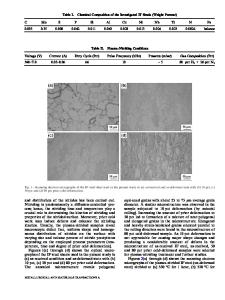Effect of Overaging Conditions on Microstructure and Mechanical Properties of Maraging Steel
- PDF / 5,191,377 Bytes
- 7 Pages / 594 x 792 pts Page_size
- 79 Downloads / 362 Views
669.018.298:621.785.72
EFFECT OF OVERAGING CONDITIONS ON MICROSTRUCTURE AND MECHANICAL PROPERTIES OF MARAGING STEEL Fawad Tariq,1 Madni Shifa,1 and Rasheed Ahmed Baloch1 Translated from Metallovedenie i Termicheskaya Obrabotka Metallov, No. 3, pp. 7 – 14, March, 2020.
The microstructure and mechanical properties of maraging steel 350 is studied after aging at 500 – 650°C. The yield strength, the ultimate strength, the impact energy, and the hardness of the steel are determined. The volume fraction of reverted austenite after the aging is assessed. The impact energy, the elongation, and the product of the ultimate strength by the elongation are shown to depend on the fraction of reverted austenite in steel 350.
Key words: maraging steels, overaging, reverted austenite, duplex steel, precipitates.
The austenite-to-martensite proportion in a micro-duplex structure can be controlled by varying the aging temperature in order to obtain the desired level of strength and ductility of the metal. At a standard composition, retained austenite does not form in the steel even after annealing (in the state of solid solution), and the structure is purely martensitic. There are data on a diffusion-controlled reverse martensite-to-austenite transformation during long-term aging of maraging steels at elevated temperatures [14, 15]. In the stage of aging for maximum hardness the content of reverted austenite (RA), i.e., the austenite formed under heating, in the steels is negligibly low. Presence of RA in the microstructure changes the electrical, magnetic and mechanical properties of the steel. For example, it has been shown in [16] that some RA affects favorably the fatigue resistance of maraging steel 300. Most studies have been devoted to the effect of the reverse martensite ® austenite transformation on the electrical and magnetic characteristics of steels [17 – 19]. The published works present the properties of the steels after aging for maximum hardness, while reported data on their properties under impact tests in the presence of RA in an overaged condition are quite scarce. The data on the effect of RA on the ductility and toughness of maraging steels with 18% Ni are contradictory. It is reported that RA affects negatively the toughness of maraging steels when it nucleates on boundaries of the former austenite grains [20]. The effect of microstructure on the fracture toughness of maraging steels 300 and 350 has been studied in [21]. It is inferred there that effect of improvement of the toughness due to the presence of RA in steel 350 is very low, while the fracture toughness of steel 300 is in-
INTRODUCTION High-strength maraging steels have been developed in the 1960s by the International Nickel Corporation (INCO). These steels contain very little carbon and enough Ni, Co and Mo to form martensite with a bcc lattice [1, 2]. The high strength of these steels is provided by precipitation of fine particles of Ni3(Mo, Ti)-type intermetallics in the structure. The optimum combination of properties, virtual absence of size di
Data Loading...











